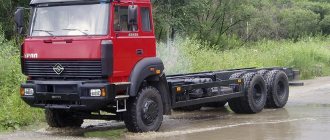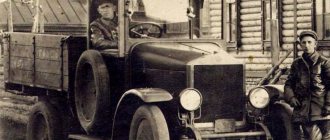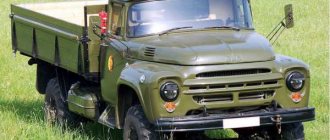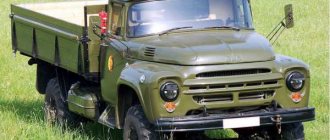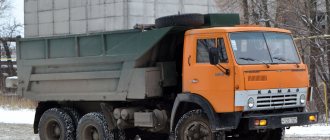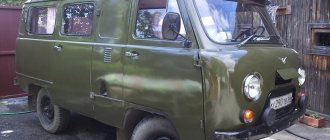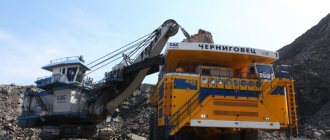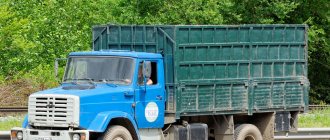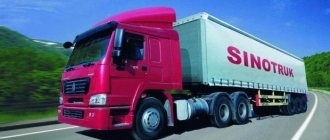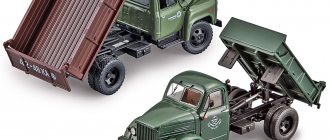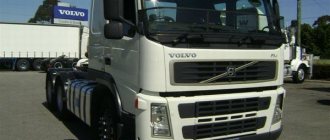Test drive without a steering wheel
Piotr Kunda, Yuri Petrov Photos by the authors, Scania AB and TRAXON
How utopian the idea of replacing humans with robots looked became clear not yesterday. There have always been enough alarmists ready to frustrate since the times of the Luddites, because the mechanization of production inevitably threatened with an increase in unemployment...
How Parisian cab drivers and horse repairmen feared the advent of the automobile era at the beginning of the 20th century. They predicted widespread unemployment throughout France and the end of the world. Alarmism has turned the other way: a labor shortage in a fast-growing sector of the economy. And by 1920, the transport industry of France, England and the United States demanded such an army of drivers, mechanics, gas station attendants, mechanics and road service workers that it even swallowed the entire Russian emigration without choking.
Dump truck Scania P 380CB 6×4 EHZ
M. Shelepenkov, photo by the author
The construction boom in Moscow and other large cities has given rise to a previously unprecedented phenomenon: construction dump trucks of well-known Western brands are selling like pie at dealers. And the most “delicious” are Scania dump trucks. This manufacturer is now the leader in the number of new trucks sold. To keep up with life, we took a Scania P 380CB 6×4 EHZ dump truck for testing.
Special working conditions for you
We offer you flexible terms for purchasing Scania dump trucks with optimal financial schemes, as well as a variety of service programs to keep dump trucks in excellent working condition.
A wide range of dump trucks for difficult operating conditions, allowing for uninterrupted delivery of cargo:
- dump trucks for any general construction work;
- dump trucks with powerful V8 engines for transporting materials to the port after crushing.
Four main factors underlying dump truck profitability:
- power;
- permeability;
- reliability;
- load capacity.
New is well forgotten old
Today you won’t surprise anyone with Scania dump trucks; hundreds of such vehicles drive onto our roads every day. Therefore, I will not describe the appearance of the dump truck being tested, especially since two years ago we tested a Scania brand dump truck. True, then it was a vehicle with an 8x4 wheel arrangement and a gross weight of 48 tons*, and now we took a three-axle dump truck with a gross weight of 39 tons. But despite the different “weight category” and a long time gap in testing, the dump trucks have a lot in common. They are equipped with the same powertrains and very similar 9-speed transmissions. Moreover, the dump truck superstructures are of the same type, from the Polish company Hyva.
This coincidence is not accidental. The Scania company produces a huge number of different chassis for dump truck superstructures, but among domestic builders the heaviest in execution and simplest in configuration models are most respected. And under such conditions, the choice of units is no longer so wide, so coincidences are inevitable. As for tipper superstructures, this is exactly the case when the price of the product fully corresponds to its quality and Hyva bodies, together with the hydraulics of the same name, are in steady demand in our market, successfully competing with domestic manufacturers of tipper superstructures.
Getting into the cabin does not cause problems at any stage
But time takes its toll, and when comparing two Scania cars, you note that the three-axle car has clearly undergone a facelift. She has a different “facial expression”, with smooth cabin lines. The impression of “newness” is enhanced by the silver color of the radiator lining; in pre-Reistaling cars it was painted in the color of the cabin. By the way, the upper part of the radiator grille now rises along with the side “cheekbones” for servicing the car. Previously, these “cheekbones” had to be moved to the sides separately from the grille, which was inconvenient.
Operational Aspects
The desire of builders to have the most reliable and durable dump truck is understandable. Construction roads are far from ideal, and the qualifications of drivers are sometimes questionable. But the pursuit of super-reliability has its limits. We carefully checked the technical characteristics of our ward and came to a disappointing conclusion - the high safety margin built into this dump truck actually provides a good reason for secretly increasing the “efficiency” of its work.
As we already know, the total weight of a dump truck is limited to 39 tons, and according to the rules, the front axle should account for 9 tons of this weight, and the two rear axles should have no more than 15 tons each. If the vehicle is not overloaded, then the axle’s carrying capacity is abundant. This is in theory. We loaded the car with sand, that is, with a load with an initially high density (1.65–1.95 g/cm3), strictly making sure not to exceed the total mass. Almost after every loader bucket we went to the scales, and still we “missed” by half a ton! At the same time, the body of the dump truck was not filled even to the sides, and if desired, another couple of dozen centners could be thrown there.
Having loaded the dump truck to its full weight, we checked how this weight is distributed along the axes in practice. It turned out not in the best way: the front axle remained underloaded by almost a ton, and the load on the rear axles exceeded the permissible limit. What if we loaded the dump truck “by eye”, without weighing, as is done in real conditions? Then constant overload of the rear axles would be ensured. It is impossible to solve this problem only with recommendations - not to overload the car; the large body volume of 16 m3 simply provokes the car to be loaded "without a head." And everyone who operates such vehicles must decide what is more important to them: “efficient” operation of dump trucks for wear and tear with constant and inevitable repairs of the chassis or long-term problem-free operation of, in general, expensive trucks. If the latter, then the dump body for this chassis must be selected with a smaller volume. At the same time, we have not yet touched upon the legal side of the issue of exceeding the permissible axle load on public roads, responsibility for which remains entirely on the conscience of the operators.
With a lifting capacity of 25 tons and a body capacity of 16 m3, the Scania P 380CB 6×4 EHZ dump truck is best suited for bulk and bulk cargo with a volumetric mass of no more than 1.50 g/cm3. These are expanded clay (0.70), dry earth (1.20), asphalt (1.35), construction waste (1.38), some types of concrete (1.20–1.50).
It is not recommended to transport sand (1.65–1.95), clay (1.50–2.00), concrete with sandstone (2.30), raw earth (1.70), crushed granite and cobblestone (1.60 ).
The productivity of a dump truck directly depends on the time spent loading it, which in turn is determined by the capacity of the excavator bucket. To load the Scania P 380CB 6×4 EHZ efficiently and quickly, an excavator or loader with a bucket capacity of 3.0–5.0 m3 is required.
Why are robots needed?
Information about the fully autonomous Scania AXL dump truck, a Swedish company part of the newly formed TRATON concern, was provided to the media in September. Although the new product is at the concept stage, the company made it clear that unmanned technologies in the mining industry will become a reality.
In essence, things were moving towards this, since the introduction of telematics and remote control in mining has been actively carried out since the late 1960s. At first, the idea was to relieve operators of hoisting and transport (HTM) and loading and delivery machines (LDM) from routine work. Then the understanding came that people had to be removed from dangerous gas-filled mines and automation introduced. In fact, a mine, like a quarry, is a production facility with closed access, which made it possible to freely experiment with unmanned systems.
The equipment can perform unmanned (that’s right!) operations itself, receiving only tasks from the operator via radio channel, cable or from a digital logistics system, since 4G networks have already been developed everywhere.
The use of autonomous transport has made it possible to streamline the process of cargo transshipment. This has been proven by the successful experience of introducing automated container ships at intermodal warehouses and seaports in Sweden, Holland, Denmark and Germany. This promises to increase the economic efficiency of the enterprise and eliminates the “human factor” from technology. Robotic engine and transmission control also reduces fuel costs and energy consumption costs. The robot is better than a human at selecting the engine operating mode based on the number of revolutions or selecting the desired gear, thereby reducing the adverse impact on the environment.
In the construction industry, which is not associated with warehouses of building materials or quarries, the situation is a little more complicated, since many unexpected obstacles arise in the path of a car or construction machine. But engineers are not asleep: in Naberezhnye Chelny, work has begun in this field as part of the Odyssey R&D.
Existing telemetry, radar and lidar systems have hit the streets and can overcome these limitations as well. So the introduction of a new autonomous control system remains a matter of time.
Technical component
The car is equipped with a six-cylinder turbodiesel engine with an intercooler producing 380 hp. It's not the most powerful diesel in Scania's construction truck range, but it has plenty of torque at low revs, allowing you to drive the vehicle confidently without having to change gears, especially on poorly surfaced construction sites or in quarries with long climbs. The engine is equipped with a white smoke limiter during cold start. It only works when the parking brake is applied and allows not only to reduce the formation of smoke around the car when parked, but also to quickly warm up a cold engine to operating temperature.
The gearbox is mechanical, 9-speed, consisting of a main 4-speed gearbox and a range multiplier that doubles the number of gears, plus one downshift - “turtle”. It is convenient to use a reduction gear for driving in cramped conditions on construction sites or repair bays. In this gear, even with full pressure on the gas pedal, the car does not accelerate more than 2.5–3 km/h. In difficult road conditions, the driver can turn on the center and cross-axle differential locks on the car, and when driving on asphalt roads at speeds over 20 km/h, use cruise control.
The full index of the vehicle that was tested looks quite cumbersome: Scania P 380CB 6×4 EHZ. But behind every letter and number lies the main characteristic of the car. The prefix "P" immediately after the brand designates the cab type. The height of the cabins of this series is slightly lower than the cabins of the R series, as a result of which one can find a rather high engine hood inside them. The numbers 380 indicate engine power. The letter “C” is the purpose class of the machine. In this case, it is a construction vehicle. The letter “B” means that this car left the Scania plant as a chassis. Numbers 6x4 – wheel formula. The abbreviation after the wheel formula denotes the various road conditions for which the car is designed, the letter “E” indicates particularly difficult operating conditions. “H” means high ground clearance, and “Z” means leaf spring suspension at the front and rear.
To direct the exhaust gases to heat the body, you need to throw this damper
The brakes on all wheels of the dump truck are drum, which is certainly justified on a heavy construction truck. There is also an engine brake, which is activated automatically when you press the brake pedal lightly. As our testing showed, it is effective not only when braking downhill, but also for reducing speed in normal mode. Frequent use of the engine brake significantly increases the life of the brake pads. The parking brake lever is now located much higher on the dashboard than before, almost at the level of the steering wheel. In case of danger, it can be used as an emergency brake by pulling the lever toward you until it locks.
In accordance with its class and purpose, the truck has a powerful spring suspension on all wheels front and rear. The spring suspension, of course, is a bit harsh, which affects the smooth ride of the car, especially when unladen. But the comfort of the driver’s workplace is ensured by a full-fledged four-point shock-absorbing cab suspension and an air-suspended seat.
If you examine the Scania P 380CB 6×4 EHZ dump truck from below, you will notice parts that have a special margin of safety. The car frame is made of side members 17.5 mm thick, and in the most critical places it is also reinforced with metal inserts of the same thickness. The car's universal joints, which are almost the size of a football, are impressive.
Characteristics of the Scania dump truck with the OFF ROAD package
- Scania wheel formula 6x4, 6x6 and 8x4;
- 35-ton towbar for towing a truck without prior unloading;
- improved P- and G-series cabin (with headlight protection, steel bumper, crankcase protection, front approach angle of 25⁰, etc.);
- high chassis plus air suspension that can withstand loads of 19, 21 and 26 tons;
- powerful Euro4 engine - 400-480 hp, improved cooling system pump, improved crankcase ventilation system, reinforced fan bearing, increased crankshaft size, etc.;
- load capacity up to 33 tons.
In any weather, on and off-road, in gravel pits and construction sites, on wet and muddy roads, on steep ascents and descents, without breakdowns or downtime, the Scania dump truck will deliver your cargo on time!
It's not the place that makes the man
You can settle into a Scania workplace with all the comforts. The driver's seat is "Medium" class - with numerous adjustments, which can get confusing if you're not used to it. But, having correctly adjusted the seat to suit you, you can work for a long time without getting tired. Checked personally! I had to drive this Scania for several hundred kilometers with or without a load, not only on the roads of the test site during testing, but also to drive the car through hours-long Moscow traffic jams, so I can say with complete confidence that everything is in order with Scania’s ergonomics.
And once the comfort of working behind the wheel is ensured, you begin to pay more attention to the “little things”. For example, the instrument cluster on new Scania cars is noticeably better than pre-restyling cars. The tachograph was “evicted” from the dashboard and placed above the windshield, and the free space was divided between the speedometer and tachometer. As a result, the tachometer scale has become larger and easier to read while driving. The cabin heating system deserves special praise. True, it warms up for a long time at idle engine speed after starting the car, but when in motion it quickly heats a small cabin, and even at maximum speed the system fan operates almost silently. The heating system deflectors are very well placed, especially those located on the sides of the instrument cluster; if desired, you can direct warm air directly to your hands lying on the steering wheel rim. We also appreciated the one located above the windshield. Upper headlights are less dirty in bad weather and produce more powerful high beams than lower ones.
Behind the passenger seat is a whole arsenal of things you need on the road.
Check in Södertälje
The machine was first shown to a narrow circle of specialists in Södertälje on October 2, 2022 at the TRATON GROUP's Innovation Day corporate show. Everyone was eager to see when this brutal outcast would appear, ready to deprive the miners of a piece of bread.
A bunch of buses, tractors and dump trucks were brought to the event. The medium-sized three-door city bus Volkswagen CO Volksbus e-Flex of the Brazilian division of Volkswagen Caminhões e Ônibus caused a visible revival. But the guests at the observation deck were craning their necks in anticipation of the long-awaited self-propelled dump car.
The guests were persuaded to be patient. And then finally the red Scania AXL appeared from nowhere! There was excitement and, without really waiting for the car to be turned off, people flocked to take selfies.
And that’s when real catharsis arose: you can’t take a picture of the cabin! Therefore, the editorial assignment of Truck Press failed miserably, and this car is unlikely to appear in the Test Drive section. It has no steering wheel! That’s why auto journalists are no longer needed here.
Correct driver position behind the wheel of a truck
More than once we have seen drivers complain about an uncomfortable seating position even when driving modern cars. Having delved into the essence of the issue, we found out that not everyone knows how to correctly adjust a modern seat with numerous adjustments. At best, drivers use two or three known adjustments out of many possible ones. Therefore, we decided to tell you how to do it correctly, and the tested Scania dump truck turned out to be a good helper for us.
Ergonomically correct adjustment of the seat must be done in the following sequence.
1. We adjust the height of the seat so that its cushion fits snugly against the hips.
2. We adjust the tilt of the entire seat to ensure even thigh support along the entire length of the seat cushion.
3. We set the depth of the pillow relative to the back so that there is a distance the size of a fist in the space between the popliteal cavity and the front edge of the seat.
4. We adjust the backrest tilt, the optimal tilt is 100–110°. At the same time, make sure that the distance from the head to the headrest remains minimal.
5. Using buttons we adjust the lumbar support of the back. The back should have good support.
6. We move the seat forward or backward until the legs are in a comfortable position when fully pressing the pedals.
7. The stiffness of the chair shock absorber can be adjusted as desired.
8. We install the steering wheel so that the driver’s arms are slightly bent at the elbows and shoulders down.
You can move the seat longitudinally using a bracket at the bottom in front of the seat (item 6). You can influence it with both your hand and your foot.
The quieter you go, the further you'll get
It won’t be possible to organize “races” on this dump truck even if you want to, and not because in the cabin in the most visible place there is a warning, understandable even without translation, “Limited speed 85 km/h”, but because the gear ratios in the car’s transmission are selected to ensure maximum service life for units experiencing heavy loads. Let me explain with an example. Of the 9 possible gears, only two are used at speeds above 40 km/h, i.e., in conditions typical for other cars, and the remaining gears are needed when starting and accelerating in various road conditions. Such a variety of “starting” gears is not at all superfluous when there are 25 tons of cargo “behind” and only 380 “horses” in the asset. Sometimes you'll go through all the gears one by one until the loaded car reaches cruising speed. Of course, such a selection of gears is tiring for the driver, especially in the city, where you have to brake at almost every traffic light and then accelerate again. But when accelerating with “overkill,” the car’s transmission, and especially the clutch, does not experience peak loads and lasts quite a long time. To prevent dashing racers from tearing up the car and speeding up starts by revving up the engine, the clutch overload protection system prevents the next gear from engaging when the engine speed exceeds 1800 rpm.
| Wheel formula | 6x4 |
| Curb weight, kg | 13 610 |
| Total weight, kg | 39 000 |
| Load capacity, kg | 25 390 |
| Body capacity, geometric m3 | 16 |
Engine:
| Scania DC11 09 380, diesel with turbocharging and intercooler, I6, 4-stroke, Euro 3 10 640 380 at 1900 rpm 1800 at 1100...1300 rpm |
Transmission
| GR 905, mechanical 9 |
| Front tires | Michelin 385/65 R22.5 |
| Rear tires | Michelin 315/80 R22.5 |
| Maximum speed with electronic limiter, km/h | 85 |
All of the above does not mean at all that the car on the road behaves like a large and clumsy “turtle”. Even with a loaded car, you can avoid falling out of dense city traffic and enjoy driving. The driver will simply be required to work more accurately and accurately with the gears. But if he accidentally makes a mistake, the electronics will prevent him from “ruining” the car, correcting the driver’s actions in time.
Series G: an intermediate option between urban delivery vehicles and long-distance highways
Russian carriers love Scania G series tractors. According to their reviews, such a machine lasts up to a million kilometers with minimal costs for spare parts, after which it can still be sold at a profit. This option is not as expensive as R or S, but much more comfortable on long journeys than P-series tractors. The vast majority of G-series cars registered in Russia, according to the analytical agency Autostat, are truck tractors.
Scania G-series tractors in our country can be found in the Griffin (simpler) and Streamline (more expensive) trim levels. The fleet of Scania G-series tractors is dominated by two-axle vehicles. For specific transportation conditions, some choose the three-axle 6x2 version with a sloth. A separate topic is the construction sector, which employs 6x4 tractors pulled by tipper semi-trailers.
The drive axle of conventional long-haul vehicles hauling trucks (it does not have hub gears, has a hypoid main gear and a differential lock) is suspended on semi-springs with 2 air springs. The front axle suspension is on leaf springs.
Engines: 9 and 13 liters; There are both diesel and gas- and ethanol-powered ones.
Power range:
- 9-liter: 280 hp, 1350 Nm; 320 hp, 1600 Nm; 340 hp, 1600 Nm; 360 hp, 1700 Nm.
- 13-liter: 370 l. s., 1900 Nm; 410 l. s., 2000 Nm; 410 l. s., 2150 Nm; 450 l. s., 2350 Nm; 500 l. s., 2550 Nm.
Gearboxes are also 8- and 12-speed, as in the previous R family.
Don't talk about love, everything has been said about it
The Scania P 380CB 6×4 EHZ dump truck is truly a very balanced vehicle that combines comfort, reliability and quality in good proportions. Its only “disadvantage” can be considered only its high cost, but with the development of leasing schemes for the purchase of vehicles, even this, as practice shows, can be successfully leveled, which is confirmed by the high demand for such equipment.
| Scania P380CB 6×4 ENZ | Scania P124CB 8×4 HZ360 “OS” No. 10, 2002 | MZKT-65151 “Volat” “OS” No. 10, 2003 | KamAZ-6520-19 Cummins “GP” No. 8, 2005 | ||||
| Vehicle weight, kg | 13 700 | 39 600 | 15 300 | 47 980 | 16 000 | 41 000 | 33 100 |
| Fuel consumption, l/100 km, at speed, km/h: | 19,7 23,0 26,0 29,8 33,4 | 27,1 30,5 32,8 37,1 40,7 | – 21,0 – 31,7 38,2 | – 35,3 – 48,0 – | 24,5 27,1 31,2 37,0 43,9 | 36,2 39,9 45,0 52,0 62,0 | 29,4 31,3 34,3 38,3 43,5 |
| Maximum speed, km/h | 88,0 | 87,6 | 97,5 | 92,0 | 82,5 | 80,6 | 107,9 |
| Fuel consumption in IGD*, l/100 km (at average speed, km/h) | 31,9 (39,5) | 63,1 (34,1) | 35,8 (38,3) | 74,7 (33,6) | 45,4 (37,0) | 78,8 (31,8) | – |
Acceleration time from standstill, s:
| 28,5 52,9 | 39,8 69,9 | – 55,9 | – – | – – | – – | – – |
| Acceleration time to 60 km/h, s | 15,6 | 50,6 | – | – | – | – | 41,0 |
| Run-out from a speed of 50 km/h, m | 798 | 1190 | 1182 | – | 790 | 935 | 976 |
| Scania P380CB 6×4 ENZ | Scania P124CB 8×4 HZ360 | MZKT 65151 | |
| Temperature, °C | 2…8 | 21 | 21 |
| Wind speed, m/s | 1…4 | 1…3 | 1…3 |
| Pressure, hPa | 991…1000 | 970 | 995 |
| Relative humidity, % | 51…82 | 42 | 45 |
P400 CB6X4EHZ with 16m3 body
Scania construction equipment – Brochure6.15 Mb
Construction vehicles Scania – Leaflet4.94 Mb
Scania for Mining - General2.47 Mb
Brochure Scania Mining Equipment6.39 Mb
Leaflet Scania equipment for the mining industry4.90 Mb
Service support solutions for Scania vehicles for quarrying1.26 Mb
Construction equipment
Scania P400 CB6X4EHZ Off-Road dump truck with body volume 16m3629.63 Kb
Scania P400 CB8x4EHZ Off-Road dump truck with body volume 20m3636.88 Kb
Scania P440 CB6X4EHZ Off-Road dump truck with body volume 16m3801.83 Kb
Scania P440 CB8X4EHZ Off-Road dump truck with body volume 20m3792.66 Kb
Dump truck Scania G400 CB6x6EHZ Off-Road with a body volume of 15 m3514.94 Kb
Equipment for the mining industry
Scania G440 CB8x4EHZ dump truck with rock body819.33 Kb
All-wheel drive dump truck Scania G440 CB6x6EHZ with body for rocks940.41 Kb
All-wheel drive dump truck Scania G440 CB8x8EHZ with body for rocks580.93 Kb
Scania G480 CB10x4EHZ dump truck with rock body1.22 Mb
Scania G440 CB8x4EHZ dump truck with body for coal1.18 Mb
Scania G480 CB10x4EHZ dump truck with body for coal1.15 Mb

